How to cite this page Comment citer cette page
Items
statue consists of is exactly
stone
-
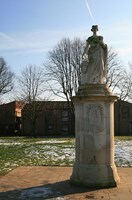 Boer War Memorial, Beeston
Boer War Memorial, Beeston -
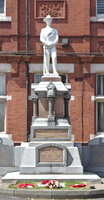 Boer War Memorial, Earlestown
Boer War Memorial, Earlestown -
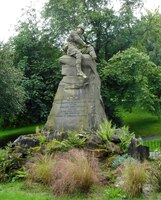 Boer War Memorial, Glasgow
Boer War Memorial, Glasgow -
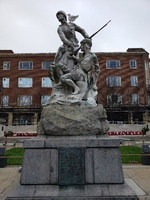 Boer War Memorial, Kingston upon Hull
Boer War Memorial, Kingston upon Hull -
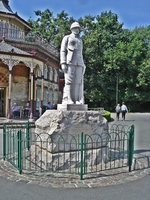 Boer War Memorial, Wigan
Boer War Memorial, Wigan -
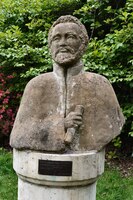 Bust of Haile Selassie The bust of Selassie, first erected in 1957, was destroyed by a group of protestors on June 30th 2020. The likely motivation for the action was a response to the killing of the Ethiopian protest singer Hachalu Hundessa in Addis Ababa the previous day.
Bust of Haile Selassie The bust of Selassie, first erected in 1957, was destroyed by a group of protestors on June 30th 2020. The likely motivation for the action was a response to the killing of the Ethiopian protest singer Hachalu Hundessa in Addis Ababa the previous day. -
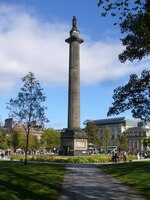 Melville Monument A very tall stone tower in St. Andrew's Square, Edinburgh, topped with a statue of Henry Dundas
Melville Monument A very tall stone tower in St. Andrew's Square, Edinburgh, topped with a statue of Henry Dundas -
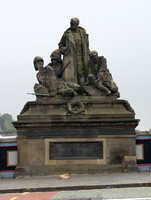 Memorial to the Kings Own Scottish Borderers, Edinburgh
Memorial to the Kings Own Scottish Borderers, Edinburgh -
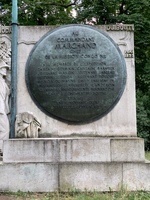 Monument to Jean-Baptiste Marchand, Paris The monument is a 12-metre-long wall, tiered into three steps rising from left to right to a height of 4.30 metres. To the left: a bas-relief depicts a line of 11 marchers, with the Europeans at the head of the line. The mission doctor is seated on a low stool, treating a soldier. A European waits beside him, keeping an eye on the column. The itinerary, marked with place names, is engraved above the column. Plants appear between the figures. Right: the statue of Marchand is detached from the monument, raised and oversized in relation to the others. Bareheaded, arms folded, he stands facing the viewer, guarding the flagpole and shield, both in bronze. This statue was damaged and removed in 1983. The names of all the Europeans and the number of African soldiers are engraved on the shield.
Monument to Jean-Baptiste Marchand, Paris The monument is a 12-metre-long wall, tiered into three steps rising from left to right to a height of 4.30 metres. To the left: a bas-relief depicts a line of 11 marchers, with the Europeans at the head of the line. The mission doctor is seated on a low stool, treating a soldier. A European waits beside him, keeping an eye on the column. The itinerary, marked with place names, is engraved above the column. Plants appear between the figures. Right: the statue of Marchand is detached from the monument, raised and oversized in relation to the others. Bareheaded, arms folded, he stands facing the viewer, guarding the flagpole and shield, both in bronze. This statue was damaged and removed in 1983. The names of all the Europeans and the number of African soldiers are engraved on the shield. -
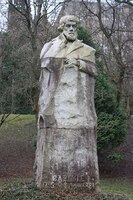 Monument to Thomas Carlyle, Glasgow
Monument to Thomas Carlyle, Glasgow -
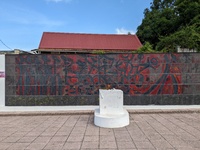 Monument Victor Schœlcher, Schœlcher The statue, created by Martinican sculptor Marie-Thérèse Lung Fou (1909-1981), depicts abolitionist Victor Schœlcher standing in full regalia. The refined, sober work of art deco inspiration honors the memory of the abolitionist politician with dignity. The artist breaks with the paternalistic, colonial vision of older monuments, notably those in Fort-de-France and Cayenne. A plaque on the pedestal recalls the decree of the Provisional Government of March 4, 1848: “No French land shall bear slaves any longer. Victor Schœlcher 1804-1893”.
Monument Victor Schœlcher, Schœlcher The statue, created by Martinican sculptor Marie-Thérèse Lung Fou (1909-1981), depicts abolitionist Victor Schœlcher standing in full regalia. The refined, sober work of art deco inspiration honors the memory of the abolitionist politician with dignity. The artist breaks with the paternalistic, colonial vision of older monuments, notably those in Fort-de-France and Cayenne. A plaque on the pedestal recalls the decree of the Provisional Government of March 4, 1848: “No French land shall bear slaves any longer. Victor Schœlcher 1804-1893”. -
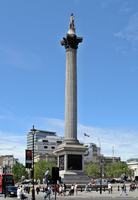 Nelson's Column Depicts a standing figure of Nelson, on top of a high Corinthina pillar with an elaborate capitol. Nelson is in a dynamic standing posture, wearing eighteenth-century military attire, and holding a sword in his left hand. The sleeve of the amputated arm is tucked into the lapels of the court. The four sides of the pedestal are decorated with four bronze reliefs, created using captured and melted French cannons. The south-facing panel, titled 'The death of Nelson' depicts a soldier with African features, holding a musket. David Olusoga notes how contemporary observers noticed this figure, their African features, and commented on it positively. Four bronze Barbary lions were added to the base of the column much later, in 1867.
Nelson's Column Depicts a standing figure of Nelson, on top of a high Corinthina pillar with an elaborate capitol. Nelson is in a dynamic standing posture, wearing eighteenth-century military attire, and holding a sword in his left hand. The sleeve of the amputated arm is tucked into the lapels of the court. The four sides of the pedestal are decorated with four bronze reliefs, created using captured and melted French cannons. The south-facing panel, titled 'The death of Nelson' depicts a soldier with African features, holding a musket. David Olusoga notes how contemporary observers noticed this figure, their African features, and commented on it positively. Four bronze Barbary lions were added to the base of the column much later, in 1867. -
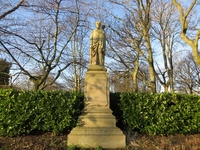 Statue of Benjamin Disraeli, Bolton
Statue of Benjamin Disraeli, Bolton -
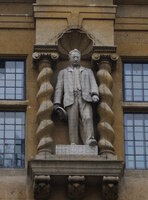 Statue of Cecil Rhodes, Oriel College, Oxford
Statue of Cecil Rhodes, Oriel College, Oxford -
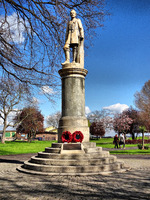 Statue of Charles Gordon, Gravesend
Statue of Charles Gordon, Gravesend -
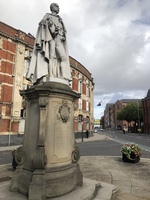 Statue of Charles Henry Wilson, Hull
Statue of Charles Henry Wilson, Hull -
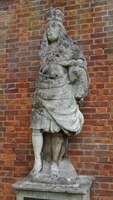 Statue of Charles II, Gloucester
Statue of Charles II, Gloucester -
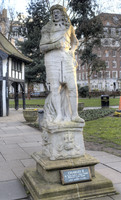 Statue of Charles II, Soho
Statue of Charles II, Soho -
 Statue of Charles Leclerc, Pontoise
Statue of Charles Leclerc, Pontoise -
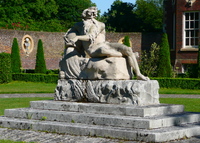 Statue of Father Thames
Statue of Father Thames -
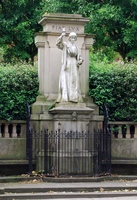 Statue of Florence Nightingale
Statue of Florence Nightingale -
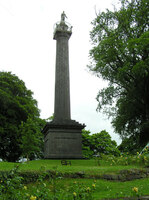 Statue of Galbraith Lowry Cole
Statue of Galbraith Lowry Cole -
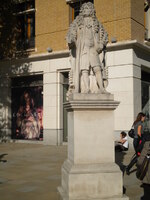 Statue of Hans Sloane, Duke of York Square Located to the left of the Saatchi Gallery
Statue of Hans Sloane, Duke of York Square Located to the left of the Saatchi Gallery -
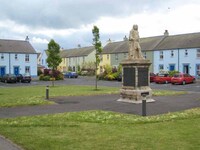 Statue of Hans Sloane, Killyleagh Duplicate of the statue of Hans Sloane in Chelsea, London.
Statue of Hans Sloane, Killyleagh Duplicate of the statue of Hans Sloane in Chelsea, London. -
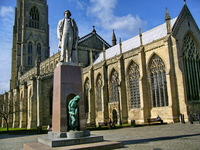 Statue of Herbert Ingram
Statue of Herbert Ingram -
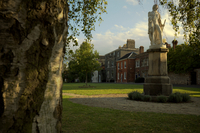 Statue of Horatio Nelson, Norwich
Statue of Horatio Nelson, Norwich -
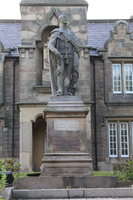 Statue of Hugh Percy, Tynemouth
Statue of Hugh Percy, Tynemouth -
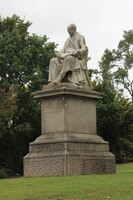 Statue of John Dinham The Dinham statue unveiling ceremony on March 26th 1866 was accompanied by a speech from Samuel Trehawke Kekewich MP (1796 - 1873), who had been awarded partial compensation as a trustee of the Hope Vale estate in Grenada in 1836.
Statue of John Dinham The Dinham statue unveiling ceremony on March 26th 1866 was accompanied by a speech from Samuel Trehawke Kekewich MP (1796 - 1873), who had been awarded partial compensation as a trustee of the Hope Vale estate in Grenada in 1836. -
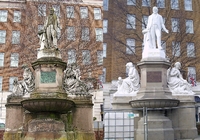 Statue of Joseph Sturge, Birmingham
Statue of Joseph Sturge, Birmingham -
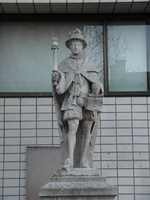 Statue of King Edward VI, St Thomas' Hospital exterior
Statue of King Edward VI, St Thomas' Hospital exterior -
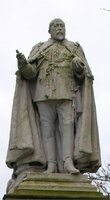 Statue of King Edward VII, Birmingham
Statue of King Edward VII, Birmingham -
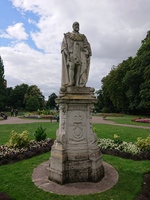 Statue of King Edward VII, Lichfield
Statue of King Edward VII, Lichfield -
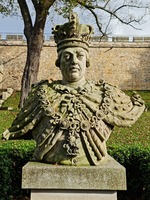 Statue of King George III, Lincoln
Statue of King George III, Lincoln -
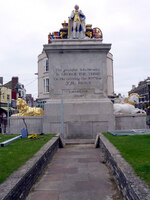 Statue of King George III, Weymouth
Statue of King George III, Weymouth -
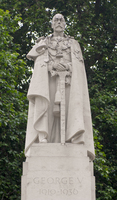 Statue of King George V
Statue of King George V -
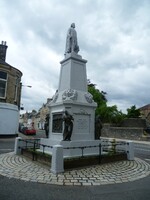 Statue of Mungo Park The statue of Mungo Park is accompanied by four bronze statues on each corner of the plinth, as well as two bronze reliefs on either side. The original statue of Park was created by Andrew Currie in 1859, while the bronze figures and reliefs were added by Thomas John Clapperton in 1913. According to the commission, the four figures were designed to symbolise 'the four tribes with whom Park came in contact in his travels in South Africa'. They supposedly represent "Peace", "War", "Slavery", and "Home Life in the Niger".
Statue of Mungo Park The statue of Mungo Park is accompanied by four bronze statues on each corner of the plinth, as well as two bronze reliefs on either side. The original statue of Park was created by Andrew Currie in 1859, while the bronze figures and reliefs were added by Thomas John Clapperton in 1913. According to the commission, the four figures were designed to symbolise 'the four tribes with whom Park came in contact in his travels in South Africa'. They supposedly represent "Peace", "War", "Slavery", and "Home Life in the Niger". - Statue of Napoléon, Adlington
-
 Statue of Prince Albert, Salford
Statue of Prince Albert, Salford - Statue of Queen Anne, Gloucester
-
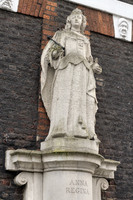 Statue of Queen Anne, Westminster
Statue of Queen Anne, Westminster -
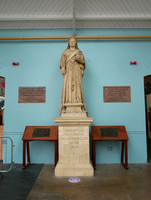 Statue of Queen Victoria, Borough Market House, Gravesend
Statue of Queen Victoria, Borough Market House, Gravesend -
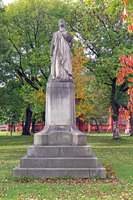 Statue of Queen Victoria, Salford
Statue of Queen Victoria, Salford -
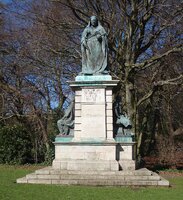 Statue of Queen Victoria, Sheffield
Statue of Queen Victoria, Sheffield -
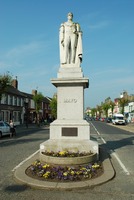 Statue of Richard Bourke
Statue of Richard Bourke - Statue of Robert Aske
-
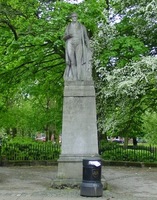 Statue of Robert Peel, Preston
Statue of Robert Peel, Preston -
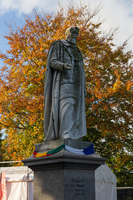 Statue of Stafford Northcote
Statue of Stafford Northcote -
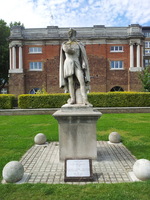 Statue of the Duke of Wellington, Greenwich
Statue of the Duke of Wellington, Greenwich - Statue of Thomas Bugeaud, Paris
-
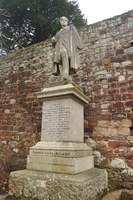 Statue of Thomas Dyke Acland, Exeter
Statue of Thomas Dyke Acland, Exeter